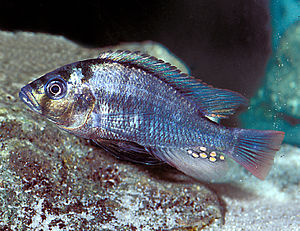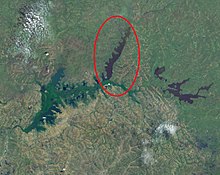Haplochromis commutabilis
| Haplochromis commutabilis | ||||||||||||
|---|---|---|---|---|---|---|---|---|---|---|---|---|

Haplochromis commutabilis |
||||||||||||
| Systematics | ||||||||||||
|
||||||||||||
| Scientific name | ||||||||||||
| Haplochromis commutabilis | ||||||||||||
| Schraml , 2004 |
Haplochromis commutabilis is an endemic species of fish from Lake Kachira ( Koki Lakes ) in Uganda. Like all Haplochromis TYPES is Haplochromis commutabilis a ovophiler mouthbrooders in which the female takes care of the brood.
morphology
Haplochromis commutabilis is a medium-sized, moderately high-backed cichlid that can reach a standard length of just over ten centimeters. The head profile is almost straight, it can be slightly concave at the level of the eyes. The lips are only slightly thickened. The pelvic fins and the soft-radiated sections of the dorsal and anal fins are drawn out in the males.
- Fin formula : dorsal XIV – XVI / 9–10, anal III / 9–10.
From Haplochromis ampullarostratus , another species of cichlid from Lake Kachira, Haplochromis commutabilis mainly differs in its greater body height (36% vs. 33% of the standard length), a shorter eye length (30.5% vs. 33.4% of the head length), a greater pre-orbital length (14.1% vs. 10.5%) and higher cheeks (23.4% vs. 20.1%).
coloring
The morphological values are almost identical to those of Haplochromis aeneocolor from the Georgsee . Both types differ in color but clearly. Male Haplochromis aeneocolor are bronze colored and also show red and green hues, male Haplochromis commutabilis , on the other hand, are mainly light blue with black markings. Some males have yellow breasts. The lips shine light blue, the gill covers are iridescent copper-colored. The dorsal fin is metallic shimmering bluish or greenish. The dorsal fin base of the hard-rayed section is black, the soft-rayed section is lined with red and shows some elongated, yellow or orange lines just before the rear edge. The radiant section of the anal fin and the entire base of the fin are black, the rest of the anal fin is slightly reddish or yellowish. It shows some orange-colored, brightly bordered egg spots of various sizes. The caudal fin is black-blue with a wide, red border on the rear edge. The pelvic fins are black. Vertical lightening behind the pectoral fins could be relics of a vertical banding pattern. The head is patterned by several dark lines, an upper and lower eye line, a band from the eyes to the corner of the mouth and a strip between the gill covers over the forehead.
Females are silver gray, with gray, transparent fins. The anal fin is also transparent, but has a slightly yellowish shimmer and shows two to three egg spots.
During courtship, the lower half of the body of the males turns black-blue below a line that extends from the upper lip over the lower edge of the eyes and the upper edge of the gill cover to the rear base of the dorsal fin. The entire tail stalk is then dark.
variability
In addition, the forehead profile of adult H. aeneocolor is distinctly concave, in Haplochromis commutabilis it is rather straight, and the males of H. commutabilis change their dentition and scaling with age, which is not the case with H. aeneocolor .
Haplochromis commutabilis has 28 to 54 teeth in the upper jaw and 16 to 36 in the lower jaw. The teeth are arranged in two to five rows. Young fish and females have two-pointed teeth, whereas in adult males they are predominantly single-pointed. The change in teeth is likely related to a change in food preferences. Females and younger males are likely to feed primarily on detritus , phytoplankton, and aquatic insects, while larger males are increasingly eating smaller fish. The shape and structure of the scales on the sides of the body also change in males. The scales become longer vertically, the granulation becomes coarser and the teeth on the rear edge of the scales look like they have been rolled flat. The biological function of the change in the scale morphology is still unknown. The species epithet ( Latin “commutabilis” = changeable) refers to the changeability of males .
source
- Erwin Schraml: The biodiversity of fish in Uganda's waters , DCG information, special issue 3.
Web links
- Haplochromis commutabilis on Fishbase.org (English)
